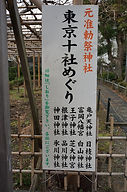普通の外にいくつかの著名な品質を持っている、と畏敬の念を起こさせるあるいかなるビーイングは、カミと呼ばれています。
Tōkyō-to, Kōtō-ku, Kameido 3-6-1
東京都江東区亀戸3-6-1
亀戸天神社
Kameido Ten Jinja
Home page (Japanese)
Dec 29, 2016
Nearest station
Kinshichō
Chūō/Hanzōmon Lines
History
Before continuing I suggest reading this piece about Sugawara Michizane, the enshrined deity at this shrine, and the first person to be deified, as Tenman-Ōkami, in Japan.
Sometime between 1644 and 1647 a descendant of Sugawara Michizane, Sugawara Ōtoriishinsuke, a priest at the Dazaifu Tenman-gū, set out on a nationwide journey to propagate the Tenjin sect and build shrines. In 1661 he found himself at what was then Kamedo village in Edo where there was already a small Tenjin Jinja. He dedicated an image of Michizane engraved with the Flying Plum Tree (tobiume). This is now considered the origin of the present shrine. The Flying Plum Tree is a reference to the legend of a plum tree in the garden of Michizane's house in Heian-kyō which he was very fond of and wrote poems about. This tree somehow learned about Michizane's death, uprooted itself and flew off to Kyūshū where it can now be seen at the Dazaifu Tenman-gū.
Four years before this, in 1657, large parts of Edo had been virtually destroyed by the Grear Meireki Fire which raged for three days in late January of that year and the Tokugawa Bakufu was focusing its reconstruction efforts on the parts of the city comprising what is now Shitaya, Aakusa and Fukagawa. As part of this effort the 4th Tokugawa Shogun donated the land on which Kamedo Tenjin now stands to be developed as a shrine and this work began in 1662. The shrine, modelled as it was on the Dazaifu Tenman-Gū, was probably initially called Higashi Dazai Tenman-Gū. In 1873 it was renamed Kamedo Jinja and in 1936 was given its current name of Kamedo Ten Jinja.
Enshrined Deities:
Main
天満大神 Tenman-Ōkami
From Merged Shrines
天菩日命 Ame-no-Hohi-no-Mikoto
In-ground Shrines:
Mitake Jinja 御嶽神社
Benten Sha 弁天社
Hanazono Jinja 花園社
Earliest mention of: 1661
Annual Festival: August 25


Description
A 15-20 minute walk from the north exit of Kinshichō Station, Kameido Ten is is one of the Ten Tōkyō Shrines and one of the Seven Edo Tenjin. It is truly an urban oasis and well worth a visit in its own right, but with over nine million people visiting it annually be prepared for crowds. About 150,000 people visit during the New Year festivities. The shrine grounds are essentially a small park with 300 plum trees and over 100 wisterias supported by 15 pergolas. The plum trees blossom in February/March, the wisterias from late April to early May, and festivals are held on both occasions. The turnout for these is large. A chrysanthemum festival is held in November but this is a smaller scale affair.
Perhaps because Michizane was an actual person there is a stronger sense of his presence in the shrine than is usually the case with more ethereal kami. The statue in the photo second from the bottom on the right is of him as a five year old. While primarily thought of as the Kami of Scholarship his calligraphy was also renowned and the ema at bottom right is from an aspiring practitioner of the art thanking Michizane for the steady improvement she is making. The ox represented at bottom centre is said to have been the one pulling Michizane's coffin when he was on his way to being buried and apparently just fell to its knees en route and refused to go any further. Touching its head or horns is said to revitalize both body and spirit. For this reason these kind of statues are known as "nade-ushi" (撫で牛, lit. "caress cow/bull).












